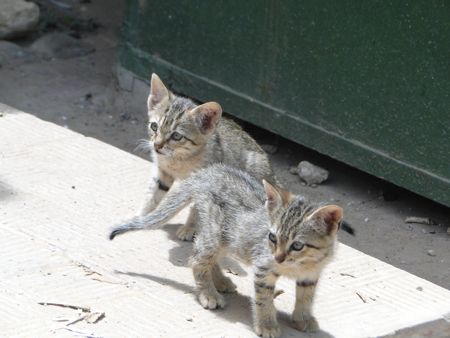
They were already there when we arrived, the cats of Dakar: waiting for no one, lazing indolently in the sun, circling anxiously when the trash was taken out, napping on roofs or the knife edges of concrete walls. Some of them allowed you to scratch them on the top of the head, but most did not. We knew them by name: "PG" (the matriarch), Lulu, Fifi, Tito, Marsupilami, Calico, Batcat, Arnold, Ashes, Jaguar.
Nights they would skirmish and prowl, revealed to us the next morning in eyes scratched out of their sockets, torn ears, scratches. We wrote more than one off as goners only to find them skulking in the shadows months later, ready for their next brawl.
Continue reading "The Cats of Dakar"
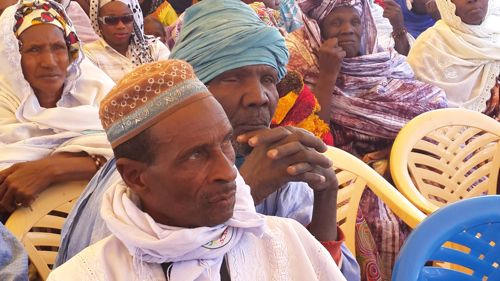
We emerged from the ridiculous luxury of air-conditioned 4-wheel vehicles at
the beginning of a patchwork of sandy trails and the thin speckles of Acacia
shadows, many hundreds of kilometers from the coast and even farther from home.
This was truly the Sahel, and I've never experienced anything like it. Perhaps
I never will.
It's easy to dismiss the far-flung corners of earth, the difficult places
where you'd never in a million years ever want to live, where you can't imagine
how people get by, where it seems life is too hard to be worth living. But
that discounts the fact that people already live there, and they're there
today, and it's hard. This is the Sahel.
Continue reading "The Sahelians"
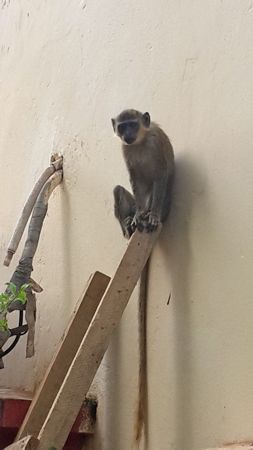
I was in Kolda, in Senegal's Casamance region, waiting for sundown and the cool of the night. A rustling in the treetops surprised me, and looking up, I watched four shadows go leaping from the branches of one tree to another. Primates! Turned out, the shadows comprised a family of monkeys, and they seemed to be pretty much at home in the trees of the hotel. Who knows, maybe they were there first! Who cares, though: after so many years at the edge of the Sahel, disappointed with the paucity of wildlife and the encroaching of the desert, it was a thrill to be face to face with some happy-looking animals.
Continue reading "The Senegal Green Monkey"
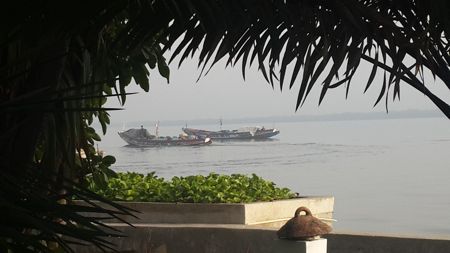
Of course the Casamance has its own name: though technically it’s part of Senegal, it’s not just another region, it’s practically another world. And that yin-yang of belonging while remaining separate is at the heart of the Casamance experience.
We flew into Ziguinchor in a ten-seater turboprop under whose spinning propellers I watched pass the Petit Cote, the dust-strewn roofs of Banjul, and then the yawning, immense Casamance itself. The Casamance River twisted and snaked back on itself through a labyrinth of mangrove thickets, brackish backwaters, oxbow lakes, and broad silty plains riven with the tracks of animals crossing what might have been hardpan dirt or meters-deep quicksand, all in a landscape that spanned from horizon to horizon in infinite flatness. If the bold landscapes of mountain ranges speak of majesty, flat riverine landscapes whisper “impermanence.” The river moves from year to year and season to season, haunted by the ghosts of swollen rainfall or the pressing heat. As it writhes, the stains of salt trace its thrashing, and trickles of rainfall cross the mudflats to join the watercourse, lined on both sides with the emerald greens of the young mangroves that will ultimately strangle them. At the edges, small villages and the squared plots of subsistence vegetable farms crouch, speckled with the canopies of the infinite trees that make not forest but savannah. How to build and plan when everything is in perpetual motion, and always will be?
Continue reading "The Casamance"
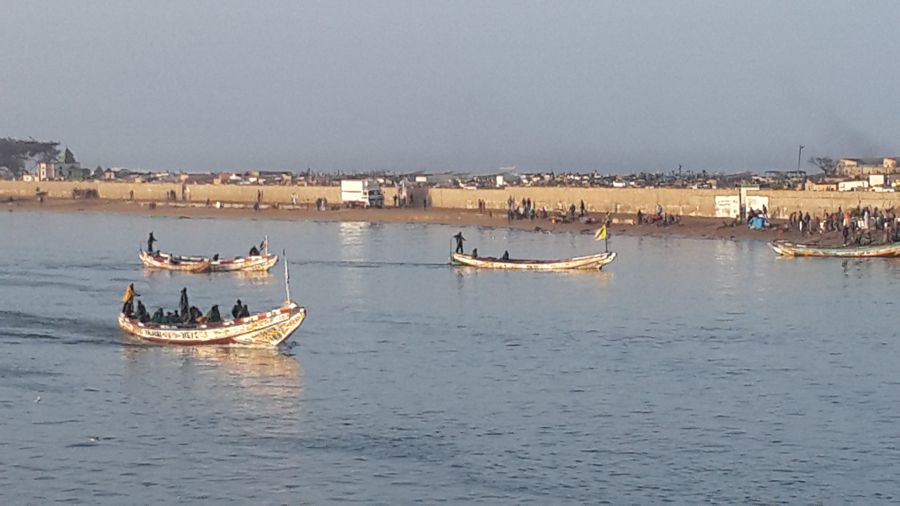
The morning sun was scarcely over the horizon and a cold wind was blowing
off the sands of the Sahel when I first saw them motoring up the steely,
smooth waters of the Senegal River: Senegal's artisanal fishing fleet, back
from a long night – or maybe several – in the cold waters of the
eastern Atlantic. A dozen wooden pirogues wended their way,
gracefully, past the island of Saint Louis where I watched them from a hotel
balcony, towards the tangled knot of ships and men that constitutes the
fishing port.
I watched them with a sense of appreciation. Other than the outboard
motor and the grey vinyl Wellington overcoats worn by the crew, not much of
that scene has changed in centuries, including the long, drawn out lines of
the pirogue itself, which was originally a river craft stretched out
and sent into the unforgiving ocean in search of bigger fish. After many
years of working among the highest levels of political leadership to
bring about meaningful reduction in Senegal's poverty, I watched these
traditional people going about their traditional craft in the traditional
way, and I thought to myself, "I haven't affected these folks in any
way at all." That's not totally true, of course: they're the rantings
of a frustrated bureaucrat impatient with the rate of progress and all the
insalubrious aspects of trusting political leaders to want and work towards
change.
Continue reading "When the Pirogues Return from Sea"
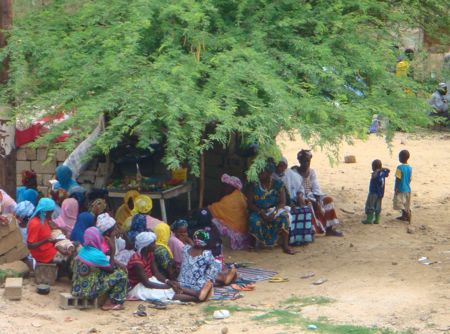
Intro: February 2012
Call it a lesson in the obvious, perhaps. I've had the pleasure of living
among squatters, and my eyes have been opened to what squatting really means in
West Africa. Our neighbors on two sides in Dakar have set up home on vacant,
yet-unbuilt lots. They are camps of families and acquaintances making their
homes on lots otherwise undeveloped. They organize themselves around sources of
water when they are available, keep their sheep, build small cooking fires,
socialize ... and then they are gone.
Continue reading "The Squatters"

Meet Albert, the best-known street dog in the Almadies neighborhood of Dakar, where we live, and the sire of probably hundreds of Dakarois puppies over the years (he's taking a well-deserved nap in this pic). He's undisputably the king of the neighborhood — even our Basenji warrior leaves him alone. As for the puppies, well his days of fatherhood came to an end, thanks to the intervention of a group of philanthropists and a program of street dog sterilization. But the whole story makes an instructive metaphor.
There's no question something needs to be done about all the underfed, fleabitten, miserable animals living a hairsbreadth from danger in the streets, gasping for shade under parked cars, scrounging through barrels, and generally living badly. And the Dakarois are scared mostly to death of dogs, so they are happy to have fewer of them. So when it comes time to develop and implement a street-dog sterilization campaign, how does it play out?
Continue reading "Albert and the Mutts: a lesson in poverty reduction"
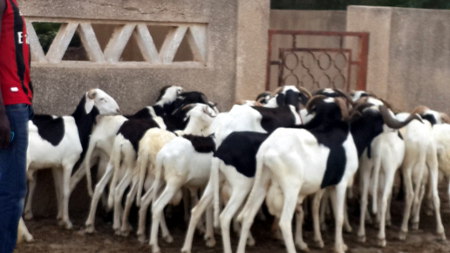
Today is Tabaski, the biggest festival of the year in Senegal. In Arabic it's Eid al-Adha (The Festival of Abraham), and commemorates the moment where, called by God to sacrifice his son Ismael, God sent a ram and Abraham sacrificed it instead of his boy. Muslims sacrifice a ram each year in remembrance.
You can tell Tabaski is coming because you see lots of sheep being transported back and forth: on the roofs of cars, hopefully trussed down under a rice sack, leaving them to admire the countryside, chewing their cud, as they whizz down the highway; also on motorcycles and not infrequently between the legs of the cyclist as he navigates Senegal's crazy traffic. You also start to see sheep tied up to a tree outside the richer households, where it's a not-so-subtle display of wealth and a frequent target of theft.
Continue reading "Run sheep, run!"
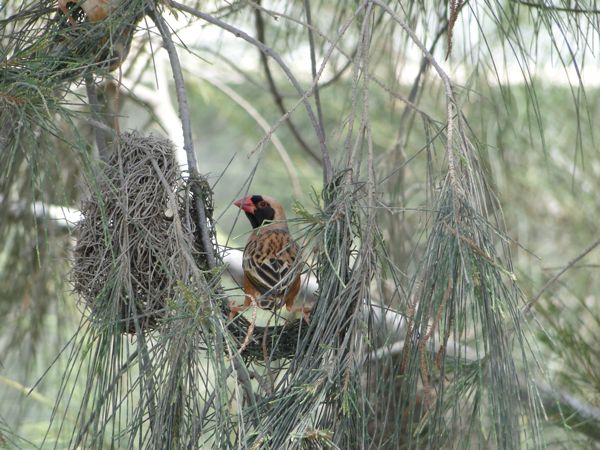
The Queleas arrived in mid-summer as the temperature in Dakar ramped up. Uninvited but hugely welcome, they have been an entertaining part of my mornings and evenings until the rains came and chased them away.
Chatty little things, several dozen Queleas began setting up shop in the Casuarina trees in our back yard, twisting and weaving bits of grass and needle into bowl-shaped nests that hung from the branches. They were so intensely chirpy that the neighbors complained, but what was not to like about so much energy and activity outside the windows? And their industry and perspicacity were a welcome respite from life in human West Africa.
Continue reading "The Queleas"
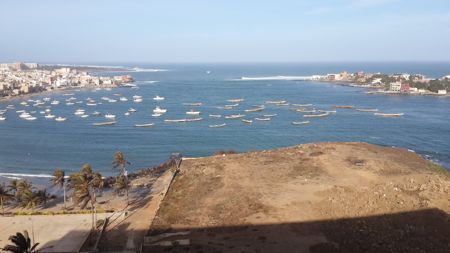
Ngor, just beyond a little channel whose twin openings to the sea permit the force of the Atlantic to pour forth in wavelets that meet in the middle in a chaos of interference: it’s an easy traverse by wooden pirogue, ending at the little island that makes for joyful Saturday beach excursions. But speckled with boats at anchor, protected by the worst of the sea’s excesses, it makes a nice paddling excursion, too. So starting in late fall of last year, I made a habit of putting my surfboard in at day’s end and paddling out across the current to Ngor and back.
It was a good workout for the arms and shoulders and therefore probably good for my surfing. It was also an exercise in Senegalese ecology, as the traverse sent me across a channel that, at its deepest, was probably only about ten or twelve feet in depth. That’s deep enough to drown in, and many Senegalese have drowned there due to careless pirogue captains overloading their vessels and racing back and forth in reckless competition with their colleagues. But, except for an instant when, as the tide turns and the sea begins to pull and the ships turn on their moorings, it was no stress for a competent swimmer on a fiberglass longboard.
Continue reading "The Traverse at Ngor"
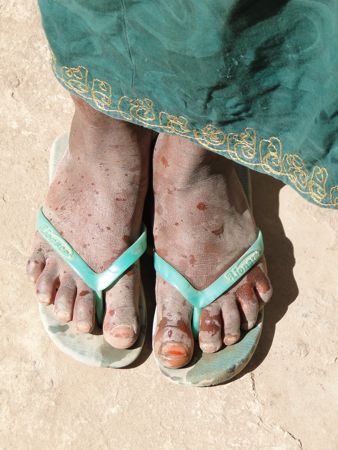
One day, the taps simply ran dry. No water. The only way to truly understand what that means is to live through it, to experience it, to suffer through it. Only then do you realize that all the other problems about which you complain are nothing in comparison, that your squatter neighbors live some version of this tragedy every day of their lives. And then you recognize how precarious human existence truly is on this earth.
We learned later - the hard way, of course - that Senegal’s Presqu’Ile of Dakar depends almost entirely for its water supply from a reservoir just south of the Senegal river, carried through a pressurized conduit to the capital. Precarious, but Manhattan has a similar relationship with the Adirondack Mountains, actually. And a critical Y-fitting in the conduit had been damaged, with no replacement piece available. Suddenly, we were dry. The news got worse before it got better: the repair would take nearly two weeks.
Continue reading "The Last Drop of Water"

They say the marketplace is where the flavor of humanity rises to the surface. Walking through the vendors' stands in Kolda, heaped high with fruits and vegetables, it was easy to believe. Kolda, a commercial center in Senegal's central Casamance region, has long known the power of trade, and its merchants and artisans do business with Africans from throughout Senegal, the Gambia, and Guinea Bissau.
Continue reading "Market Day in Kolda"
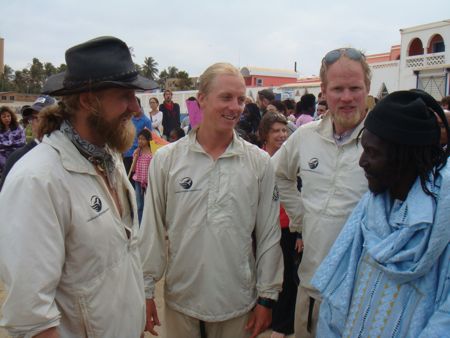
Bravery is relative, as is adventure. In Indonesia, I climbed volcanic Mount Batur before dawn, and reached the summit feeling triumphant only to find a Balinese 10 year old had done the same, wearing flip-flops and carrying a case of soda on his head to sell to us. There's always a team braver than you and it's inspiring to meet those who coax you into discovery and adventure. In Senegal, that team was OAR Northwest.
Continue reading "The Rowers"
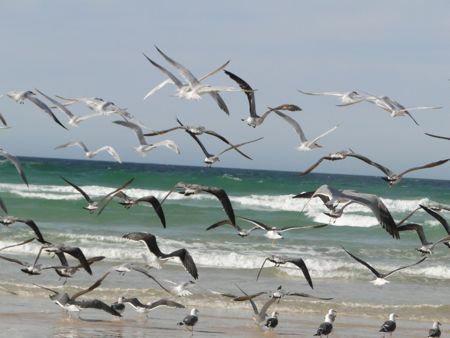
Lac Rose was only a couple of kilometers away from Dakar, but given urban traffic/chaos, dusty back roads, one main thoroughfare blocked by a day market, and another closed for construction, it took us over an hour to reach. Surely there was an easier way home? There was, once you put on your lucky adventure hat.
Continue reading "The Sandy Ride Home"
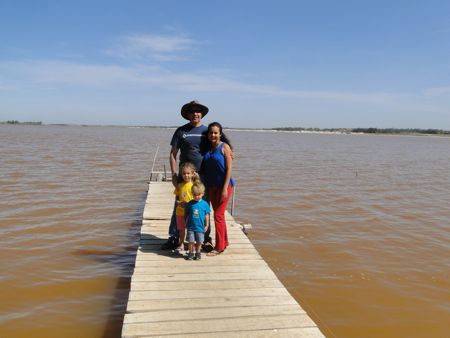
Not far northeast of Dakar on the Cap Vert peninsula is Lac Rose, a shallow freshwater lake that decades of evaporation have converted into a salt pan whose color is somewhat pinkish in the right conditions of sunlight. We went to go have a look.
We went as much to enjoy a day outing as to debunk this picture posted in Reddit; it's obviously been photoshopped six ways to Sunday. But hey, the Internet is a huge bag of lies, right?
Continue reading "Lac Rose"















